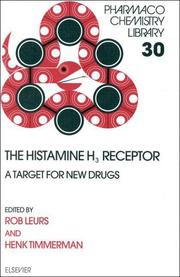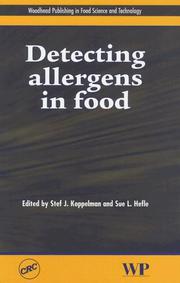| Listing 1 - 4 of 4 |
Sort by
|

ISBN: 9780444829368 0444829369 9780080534008 0080534007 9786611057527 1281057525 Year: 1998 Publisher: New York : Elsevier,
Abstract | Keywords | Export | Availability | Bookmark
 Loading...
Loading...Choose an application
- Reference Manager
- EndNote
- RefWorks (Direct export to RefWorks)
In the early eighties when the H3 receptor was identified, many thought that an H3 ligand, an agonist or an antagonist, would become available as a therapeutic agent. This has not occurred. The reason for this could be the fact that many investigators consider histamine mainly, if not only, as a mediator present in for example mast cells being released during allergic events. However, it has become apparent that histamine is an important neurotransmitter. Its role in the nervous system, especially in the central part of it, is rather extensive. The H3 recepto
Histamine --- Neurotransmitter receptors. --- Cell receptors --- Hormone receptors --- Neural receptors --- Receptors, Neurotransmitter --- Chemoreceptors --- Histamine receptors --- Receptors, Histamine --- Receptors.
Book
ISBN: 9780120133215 0120133210 9781483266886 1483266885 1322280010 Year: 1991 Publisher: London, England ; San Diego, California : Academic Press : Harcourt Brace Jovanovich, Publishers,
Abstract | Keywords | Export | Availability | Bookmark
 Loading...
Loading...Choose an application
- Reference Manager
- EndNote
- RefWorks (Direct export to RefWorks)
Advances in Drug Research, Volume 21 comprises three chapters that deal with the general subject, specific therapeutic class, and chemical family of diverse drugs. The first chapter of this book discusses the absorption and distribution of drugs in the lymphatic system. A presentation of the anti-infective quinolones is provided in Chapter 2, while the design and therapeutic potential of peptides are elaborated in Chapter 3. Other topics covered include lymphotropic carriers and the lymph uptake mechanism; basis of circulation in lymphatic transport of molecules through various routes of admin
Drugs --- Histamine --- Medicinal plants. --- Drug plants --- Plants, Useful --- Botanical drug industry --- Botany, Medical --- Materia medica, Vegetable --- Psychotropic plants --- Histamine receptors --- Receptors, Histamine --- Cell receptors --- Chemoreceptors --- Pharmaceutical research --- Pharmacology --- Research. --- Receptors. --- Research
Book
ISBN: 9780120133208 0120133202 1322280002 1483265439 Year: 1991 Publisher: London, [England] ; San Diego, California : Academic Press,
Abstract | Keywords | Export | Availability | Bookmark
 Loading...
Loading...Choose an application
- Reference Manager
- EndNote
- RefWorks (Direct export to RefWorks)
Advances in Drug Research, Volume 20 focuses on the general themes of drug research and description of specific drug classes. This book is divided into four chapters. Chapter 1 discusses the extrapolation of toxicological and pharmacological data from animals to humans. The second chapter deals with the tissue binding of drugs, considering the relative ponderal importance of tissue versus blood macromolecules. The therapeutic use of plants and consumption of medicinal plants are elaborated in Chapter 3. The last chapter covers the field of histaminergic agonists and antagonists, describing bre
Drugs --- Histamine --- Medicinal plants. --- Drug plants --- Plants, Useful --- Botanical drug industry --- Botany, Medical --- Materia medica, Vegetable --- Psychotropic plants --- Histamine receptors --- Receptors, Histamine --- Cell receptors --- Chemoreceptors --- Pharmaceutical research --- Pharmacology --- Research. --- Receptors. --- Research

ISBN: 1280544449 9786610544448 1591249775 1845690559 9781845690557 9781591249771 1855737280 9781855737280 0849325749 9780849325748 Year: 2006 Publisher: Cambridge : Woodhead Publishing Limited,
Abstract | Keywords | Export | Availability | Bookmark
 Loading...
Loading...Choose an application
- Reference Manager
- EndNote
- RefWorks (Direct export to RefWorks)
Allergens pose a serious risk to consumers, making effective detection methods a priority for the food industry. Bringing together key experts in the field, this important collection both reviews the range of analytical techniques available and their use to detect specific allergens such as nuts, dairy and wheat products. The first part of the book discusses methods of detection such as the use of antibodies and ELISA techniques. Part 2 reviews techniques for detecting particular allergens, whilst the final part of the book explores how detection methods can be most effectively applied.
Allergens. --- Allergens --- Chemical tests and reagents --- Food --- Food allergy --- Immunologic Tests --- Molecular Probe Techniques --- Hypersensitivity, Immediate --- Antigens --- Immunologic Techniques --- Biological Factors --- Hypersensitivity --- Investigative Techniques --- Laboratory Techniques and Procedures --- Analytical, Diagnostic and Therapeutic Techniques and Equipment --- Immune System Diseases --- Chemicals and Drugs --- Diagnosis --- Diseases --- Immunoassay --- Food Hypersensitivity --- Biology --- Health & Biological Sciences --- Microbiology & Immunology --- Allergy, Food --- Food Allergy --- Hypersensitivity, Food --- Allergies, Food --- Food Allergies --- Food Hypersensitivities --- Hypersensitivities, Food --- Foodborne Diseases --- Allergen --- Pollen --- Immunochromatographic Assay --- Assay, Immunochromatographic --- Assays, Immunochromatographic --- Immunoassays --- Immunochromatographic Assays --- Antemortem Diagnosis --- Diagnoses and Examinations --- Examinations and Diagnoses --- Postmortem Diagnosis --- Diagnose --- Antemortem Diagnoses --- Diagnoses --- Diagnoses, Antemortem --- Diagnoses, Postmortem --- Diagnosis, Antemortem --- Diagnosis, Postmortem --- Postmortem Diagnoses --- Disease --- Diseases of Immune System --- Immune Diseases --- Immunological Diseases --- Immune Disorders --- Immune System Disorders --- Immunologic Diseases --- Disease, Immune --- Disease, Immune System --- Disease, Immunologic --- Disease, Immunological --- Disorder, Immune System --- Immune Disease --- Immune Disorder --- Immune System Disease --- Immune System Disorder --- Immunologic Disease --- Immunological Disease --- Investigative Technics --- Investigative Technic --- Investigative Technique --- Technic, Investigative --- Technics, Investigative --- Technique, Investigative --- Techniques, Investigative --- Allergic Reaction --- Allergy --- Allergic Reactions --- Allergies --- Hypersensitivities --- Reaction, Allergic --- Reactions, Allergic --- Biologic Agents --- Biologic Factors --- Biological Factor --- Factor, Biologic --- Factor, Biological --- Factors, Biological --- Biologic Agent --- Biological Agent --- Biological Agents --- Agent, Biologic --- Agent, Biological --- Agents, Biologic --- Agents, Biological --- Biologic Factor --- Factors, Biologic --- Biological Products --- Antibody Dissociation --- Immunologic Technic --- Immunologic Technics --- Immunologic Technique --- Immunological Technics --- Immunological Techniques --- Technic, Immunologic --- Technics, Immunologic --- Technique, Immunologic --- Techniques, Immunologic --- Antibody Dissociations --- Dissociation, Antibody --- Dissociations, Antibody --- Immunological Technic --- Immunological Technique --- Technic, Immunological --- Technics, Immunological --- Technique, Immunological --- Techniques, Immunological --- Allergy and Immunology --- Immunity --- Immunochemistry --- Antigen --- Atopic Hypersensitivity --- Hypersensitivity, Atopic --- Hypersensitivity, Type I --- IgE-Mediated Hypersensitivity --- Type I Hypersensitivity --- Atopic Hypersensitivities --- Hypersensitivities, Atopic --- Hypersensitivities, IgE-Mediated --- Hypersensitivities, Immediate --- Hypersensitivities, Type I --- Hypersensitivity, IgE-Mediated --- IgE Mediated Hypersensitivity --- IgE-Mediated Hypersensitivities --- Immediate Hypersensitivities --- Immediate Hypersensitivity --- Type I Hypersensitivities --- Antigen-Antibody Reactions --- Histamine --- Histamine H1 Antagonists --- Latex Hypersensitivity --- Molecular Probe Technic --- Molecular Probe Technics --- Molecular Probe Technique --- Technic, Molecular Probe --- Technics, Molecular Probe --- Technique, Molecular Probe --- Techniques, Molecular Probe --- Probe Technic, Molecular --- Probe Technics, Molecular --- Probe Technique, Molecular --- Probe Techniques, Molecular --- Diagnosis, Immunologic --- Immunologic Diagnosis --- Immunologic Test --- Immunological Tests --- Tests, Immunologic --- Diagnosis, Immunological --- Immunodiagnosis --- Diagnoses, Immunologic --- Diagnoses, Immunological --- Immunodiagnoses --- Immunologic Diagnoses --- Immunological Diagnoses --- Immunological Diagnosis --- Immunological Test --- Test, Immunologic --- Test, Immunological --- Tests, Immunological --- Foods --- Dinners and dining --- Home economics --- Table --- Cooking --- Diet --- Dietaries --- Gastronomy --- Nutrition --- Chemical reagents --- Reagents, Chemical --- Indicators and test-papers --- Composition --- Prevention --- diagnosis --- methods --- Allergie en voeding --- Voedselallergieën --- 616.39 --- Food Hypersensitivity. --- analysis. --- methods. --- Primitive societies --- Chemical tests and reagents. --- Composition. --- Prevention.
| Listing 1 - 4 of 4 |
Sort by
|

 Search
Search Feedback
Feedback About UniCat
About UniCat  Help
Help News
News